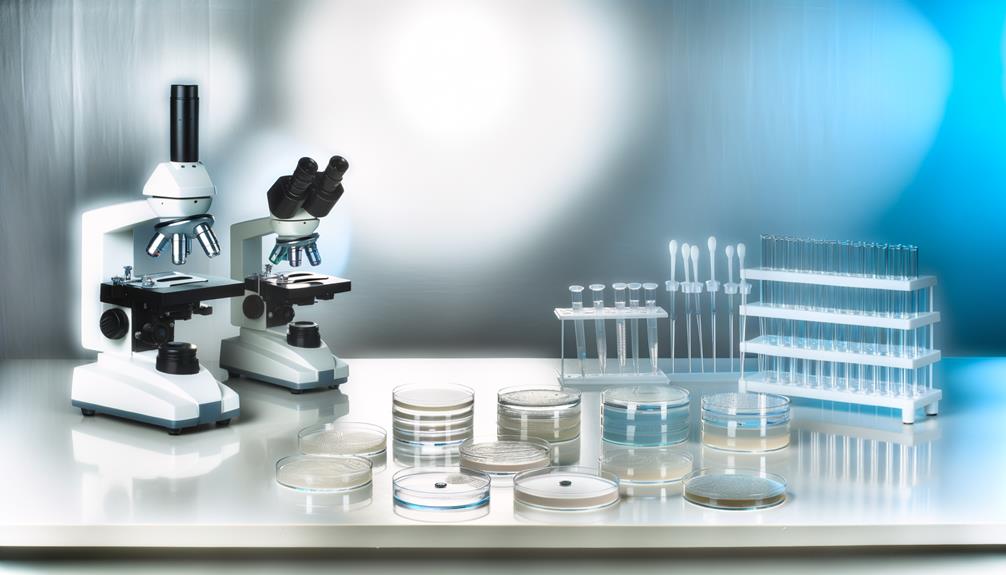You're about to explore the world of microbial culture techniques, where scientists harness the power of microorganisms to reveal breakthroughs in biotechnology, healthcare, and beyond. Microbial cultures involve growing microorganisms in controlled environments, using various types of media, such as solid, liquid, and semi-solid media, each with its own advantages. You'll learn how to inoculate and incubate cultures, isolate and identify microorganisms, and control contamination risks. As you continue, you'll discover the vast applications of microbial culture techniques in biotechnology, from biofuel production to pharmaceuticals, and tap into the secrets of these tiny, yet powerful, organisms.
Types of Microbial Culture Media
You'll encounter various types of microbial culture media, each designed to support the growth of specific microorganisms or to facilitate specific biochemical reactions.
These media can be broadly classified into solid, liquid, and semi-solid media. Solid media, such as agar plates, provide a stable surface for microbial growth, while liquid media, like broth, support the growth of microorganisms in suspension. Semi-solid media, like agar slants, offer a combination of both.
You'll also come across defined media, which contain a precise amount of nutrients and salts, and undefined media, which have varying concentrations of nutrients.
Selective media, enriched with specific nutrients or inhibitors, are designed to isolate specific microorganisms or inhibit the growth of contaminants. Enrichment media, on the other hand, are formulated to enhance the growth of specific microorganisms.
Additionally, you'll encounter specialized media, such as chromogenic media, which contain chromogenic substrates that change color in response to specific enzymatic reactions.
Understanding the different types of microbial culture media is essential for successful cultivation and identification of microorganisms.
Inoculation and Incubation Techniques
With the right microbial culture media in hand, it's time to introduce the microorganisms to their new environment, and proper inoculation and incubation techniques are vital to facilitate healthy growth and accurate results.
You'll need to inoculate your culture media by transferring a small, isolated sample of microorganisms to the media. This can be done using an inoculation loop or swab, taking care to avoid contamination.
Once inoculated, the culture media needs to be incubated at a controlled temperature, typically between 25°C to 37°C, depending on the microorganism's ideal growth conditions.
Incubation allows the microorganisms to grow and multiply, and the duration of incubation varies from a few hours to several days or even weeks.
You should monitor the culture's growth and make adjustments as needed to maintain favorable conditions.
Proper inoculation and incubation techniques are essential to promote the growth of healthy, pure microbial cultures, which are critical for downstream applications such as identification, characterization, and further experimentation.
Isolation and Identification Methods
Microbiologists employ various isolation and identification methods to separate, characterize, and confirm the presence of specific microorganisms in a culture, including streak plates, pour plates, and selective media.
These techniques are used to isolate pure cultures from mixed populations, which is essential for understanding microbial physiology and genetics.
Streak plates, for instance, involve spreading a sample across an agar surface to create isolated colonies.
Pour plates, on the other hand, involve mixing a sample with molten agar, which is then poured into a plate to solidify.
Selective media, enriched with specific nutrients or inhibitors, allow you to target specific microorganisms while suppressing others.
These methods enable you to distinguish between microorganisms based on their morphology, growth characteristics, and biochemical properties.
By combining these techniques, you'll be able to identify microorganisms with precision and accuracy.
As you work with microbial cultures, mastering these isolation and identification methods is vital for achieving reliable results and making meaningful discoveries.
Contamination Control Strategies
As you endeavor to isolate and identify specific microorganisms, controlling contamination becomes paramount to guarantee the integrity of your cultures and the validity of your results.
Contamination can arise from various sources, including airborne particles, skin cells, and equipment.
To mitigate these risks, stringent contamination control strategies must be implemented.
Firstly, you should maintain a clean working environment by regularly sanitizing your workspace and equipment.
Wear personal protective equipment, such as gloves and lab coats, to prevent skin cells and other contaminants from entering your cultures.
When handling cultures, use aseptic techniques, including flaming inoculation loops and working in a laminar flow hood.
Additionally, you should implement quality control measures, such as sterility testing and media quality assurance, to detect any potential contaminants.
Implementing these strategies will substantially reduce the risk of contamination, guaranteeing the accuracy and reliability of your results.
Applications in Biotechnology
You can exploit the unique properties of microorganisms to develop innovative biotechnological applications, such as biofuel production, bioremediation, and biosensors.
By harnessing the metabolic capabilities of microorganisms, you can create novel products and processes that transform industries. For instance, microorganisms can convert plant biomass into biofuels, providing a sustainable alternative to fossil fuels.
In bioremediation, microorganisms break down pollutants, cleaning contaminated soil and water. Biosensors, which utilize microorganisms to detect specific analytes, have applications in medical diagnostics and environmental monitoring.
You can also use microorganisms to produce high-value compounds, such as antibiotics, vitamins, and amino acids.
Microbial fermentation is employed in the production of food additives, like citric acid and lactic acid. In addition, microorganisms can be engineered to express recombinant proteins, used in pharmaceuticals, and vaccines.
The possibilities are vast, and continued research in microbial culture techniques will reveal new opportunities in biotechnology. By mastering microbial culture techniques, you'll be equipped to develop novel biotechnological applications that transform industries and improve lives.

Erzsebet Frey (Eli Frey) is an ecologist and online entrepreneur with a Master of Science in Ecology from the University of Belgrade. Originally from Serbia, she has lived in Sri Lanka since 2017. Eli has worked internationally in countries like Oman, Brazil, Germany, and Sri Lanka. In 2018, she expanded into SEO and blogging, completing courses from UC Davis and Edinburgh. Eli has founded multiple websites focused on biology, ecology, environmental science, sustainable and simple living, and outdoor activities. She enjoys creating nature and simple living videos on YouTube and participates in speleology, diving, and hiking.

